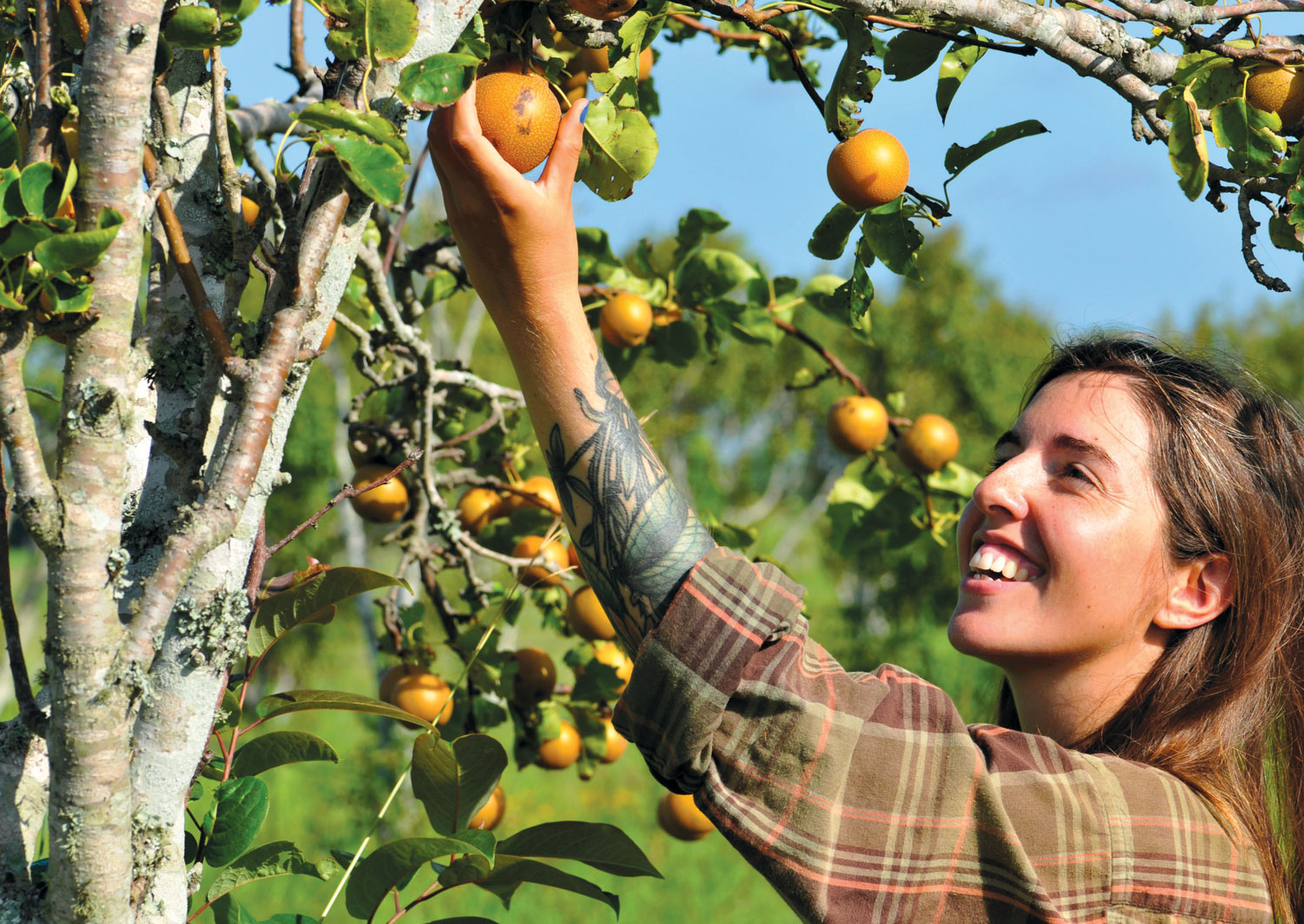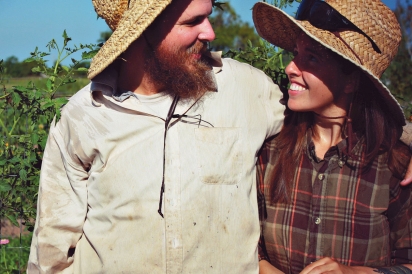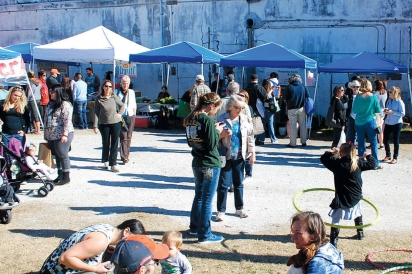Moon Dog Farms and Galveston’s Own Farmers Market
Excelling at Serving Farmers and Embracing Community
Casey McAuliffe keeps her hands full, and not just with soil or seedlings or vegetables and fruit and flowers that she and her partner, Alex McPhail, cultivate at Moon Dog Farms in Santa Fe, Galveston County. Her hands are also full with managing Galveston’s Own Farmers Market (GOFM). Casey, 28, and Alex, 29— dubbed “McFarmers” in Casey’s ebullient blog and newsletter—began their farm in January 2013. GOFM opened only months before, in October 2012, just in time to become Moon Dog’s main venue and for the McFarmers to help Cate Black, 34-year-old architect at a design/ build firm and GOFM spearhead, direct the new market.
And it’s a humming one, a gently joyful party every Sunday morning on Post Office Street, just across from a flourishing community garden and surrounded by trendy businesses on 25th. Vendors and musicians line the perimeter, while Casey—wide-smiling and welcoming—occupies the center with representatives of local organizations. Cate, GOFM community liaison since Casey replaced her as manager in late 2014, is a regular, shopping and conferring intently about market development.
The McFarmers, graduates of Southwestern University, farmed in New York and North Carolina before returning to Texas in 2012. GOFM appealed to them over much older, larger markets in Houston because of two features they consider essential and credit to Cate’s diligent organizational work. One is strict enforcement of the rule that vendors sell only what they produce and not “re-sell” purchased produce, a rule intended to prevent consumer fraud that many markets have but seldom enforce. Texas, unlike some other states, including California, does not prosecute such fraud, and so fraud-free markets depend entirely on market management.
The second GOFM feature that drew the McFarmers is its participation in the Supplemental Nutrition Assistance Program (SNAP), formerly known as the food stamps program, which requires authorization by the U.S. Department of Agriculture, a time-consuming process that deters many markets. But GOFM, 16 months after opening, distinguished itself as the first Houston-area farmers market to accept SNAP (Supplemental Nutrition Assistance Program) food-assistance vouchers, and remained the only one for two-and-a-half years until April 2015, when Houston’s East End Market opened and became the second.
“Cate Black shouldered myriad duties—physical, bureaucratic and mental—and burned many candles end-to-end to breathe life into our market,” Casey says. “Cate pushed the paper to make our market SNAP-eligible. She envisioned our market as a true community hub serving everyone.” Cate’s knowledge of farmers markets is both personal and professional. After graduating from Texas A&M University, she lived nine months in Sahuayo, Michoacan, Mexico. “I fell in love with markets there,” she says, “and the food and community life.” This love grew as she entered graduate school at the University of Houston in 2005, and discovered fledgling markets in the central city. For her master’s thesis, she designed a possible Montrose market, based on researching markets throughout the U.S.
In 2011, she moved to Galveston, which had no market. “I really felt the lack,” she says, “and I started talking to people.” These included the owner of the vacant lot that became the market site, a beekeeper, an aquaponics producer, local business owners and the staff at St. Vincent’s House, a free community clinic. In April 2012, she formed a board and began securing the market’s nonprofit designation and its authorization for SNAP.
Growing up in Katy, Cate received school-lunch assistance after her father lost his job. “I know how it feels to need help buying food,” she says. Beyond this personal identification, she has gained a broader, social perspective on serving low-income people from St. Vincent’s staff. “They’ve tuned me in,” she says, “and taught me the necessity of access to good food for everyone.” Including SNAP customers not only helps low-income people afford fresh food at the market, democratizing a venue sometimes criticized as elitist, it also helps farmers serve them while maintaining prices necessary for making a living. Moon Dog Farms, Casey says, exemplifies this dilemma.
“Alex and I want to sell our food to those who don’t have expendable income. Yet we have to charge a real price, one that we weigh against the labor of sowing the seed, tending the beds, harvesting each crop by hand and preparing it for sale. The ‘real price of food’ means our offerings cost more than what many are used to. Being in a market that actively works to bring low-income households into the process of teaching everyone the benefit of eating fresh, local produce is a win-win for us.”
Casey works steadily to increase access even further. Last February, she initiated a SNAP Double Dollars program. Such programs double the dollars of SNAP clients up to a certain amount per market day, and many of them are funded by grants. GOFM, however, began with its own funds. “We felt we could set aside from our own coffers up to $15 per market per SNAP customer,” Casey says. This quickly spurred GOFM to solicit contributions from the community, and individual donations of $5 to $250 flowed in. Casey is now applying to local philanthropies for additional funds, and working to get GOFM authorized to accept vouchers from the Women, Infants and Children assistance program.
She proudly notes that theirs is the only Double Dollars program in greater Houston. “We’ve seen the impact, with brand-new customers arriving every week, nearly every one of them mothers accompanied by children,” she says. “Now ask me why we’re doing it.”
Pamela Walker is a writer and local farm and food activist. Her book Growing Good Things to Eat in Texas was published by TAMU Press in 2009.







